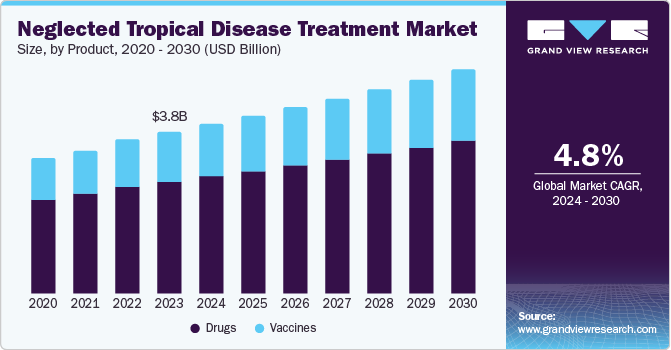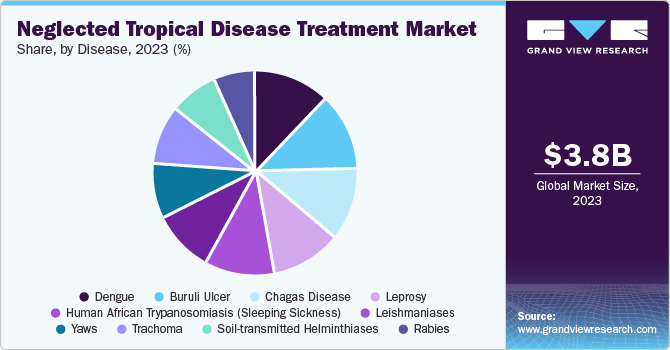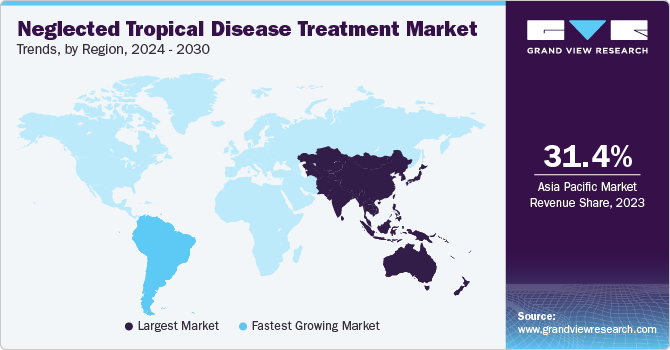
Neglected Tropical Disease Treatment Market Size, Share & Trends Analysis Report By Disease (Dengue, Rabies, Trachoma, Chagas Disease), By Product (Drugs, Vaccines), By Region, And Segment Forecasts, 2024 - 2030
- Report ID: GVR-3-68038-787-2
- Number of Report Pages: 90
- Format: PDF, Horizon Databook
- Historical Range: 2018 - 2022
- Forecast Period: 2024 - 2030
- Industry: Healthcare
NTD Treatment Market Size & Trends
The global neglected tropical disease treatment market size was valued at USD 3.78 billion in 2023 and is expected to grow at a CAGR of 4.8% from 2024 to 2030. The market growth is attributed to increased government initiatives and rising awareness about neglected tropical diseases (NTDs), which are crucial, particularly as cases surge in tropical and subtropical regions. In addition, global health programs, such as the WHO's roadmap for NTD elimination, enhance treatment accessibility. Furthermore, pharmaceutical companies' ongoing research and development investments contribute significantly to market growth.

Neglected tropical diseases (NTDs) represent many communicable illnesses in tropical and subtropical regions across 149 countries, impacting over one billion individuals and costing developing economies billions annually. These diseases, including dengue fever, lymphatic filariasis, Chagas disease, trachoma, and leishmaniasis, are termed "neglected" due to their prevalence among impoverished populations and the historical lack of attention they receive compared to other health issues. Their existence is often linked to inadequate sanitation, poor water quality, and limited healthcare access in developing areas. The increasing incidence of NTDs in emerging nations is attributed to insufficient hygiene practices and a lack of basic services such as clean water. Governments actively promote awareness about available treatments to encourage better health practices among communities.
Furthermore, many companies are investing substantial resources in research and development to create new treatment options for these diseases. This concerted effort from both the public and private sectors aims to address the health challenges NTDs pose while fostering improved living conditions for affected populations. By tackling these diseases, there is potential for significant economic benefits, including enhanced productivity and reduced healthcare costs for communities burdened by NTDs.
Product Insights
Drugs led the market and accounted for the largest revenue share of 69.3% in 2023, attributed to increased government initiatives that have increased awareness and funding for NTD treatments, recognizing their significant impact on public health and economic stability. In addition, the rising incidence of diseases such as dengue fever and Chagas in tropical regions has created a pressing demand for effective medications. Furthermore, pharmaceutical companies are responding by investing in research and development to develop innovative treatments that address these urgent health challenges.
The vaccine is expected to grow at a CAGR of 5.3% over the forecast period, owing to global health goals, including NTDs in the United Nations Sustainable Development Goals, which have mobilized international support and funding, fostering a conducive environment for vaccine development. In addition, increased collaboration between governments, NGOs, and pharmaceutical companies has accelerated research efforts. Furthermore, the urgent need for preventive measures against diseases such as trachoma and leishmaniasis drives investments in vaccine innovation, ensuring effective solutions reach vulnerable populations worldwide.
Disease Insights
Dengue dominated the market and accounted for the largest revenue share of 11.5% in 2023, attributed to the rising number of dengue cases globally, particularly in tropical regions, which has heightened the demand for effective treatments, with reports indicating millions of cases annually that prompt urgent healthcare responses. As seen in various countries, enhanced government awareness campaigns and funding for dengue prevention and treatment are crucial. Furthermore, pharmaceutical companies are heavily investing in research and development to create new drugs and vaccines, aiming to address the urgent need for effective solutions against dengue fever.

Buruli ulcer is expected to grow at a CAGR of 7.1% over the forecast period, owing to rising prevalence and increased awareness. The growing incidence of Buruli ulcers in endemic regions, particularly Africa, has drawn attention to the disease and its treatment needs. Government and NGO initiatives to raise awareness about Buruli ulcer symptoms and treatments are essential for early diagnosis and intervention. Furthermore, increased funding for research into Buruli ulcer treatments is vital as pharmaceutical companies seek to develop effective therapies and improve existing treatment protocols.
Regional Insights
The neglected tropical disease market in North America is expected to grow significantly over the forecast period. This growth is driven by the presence of a transient population from endemic regions. It increases awareness of neglected tropical diseases, prompting healthcare providers to focus on prevention and treatment strategies. Furthermore, partnerships between government agencies and pharmaceutical companies facilitate the development of new therapies for diseases such as dengue and leishmaniasis, thereby fueling the market growth in the region.
U.S. Neglected Tropical Disease Treatment Market Trends
The U.S. neglected tropical disease market is expected to experience substantial growth in 2023, owing to extensive funding for global health initiatives to combat these diseases. In addition, programs by agencies such as USAID focus on eliminating or controlling various NTDs through effective medicine distribution and public health campaigns. Furthermore, the U.S. pharmaceutical industry is also actively engaged in developing new drugs and vaccines for neglected tropical diseases, leveraging its advanced research capabilities. This commitment to addressing global health challenges significantly contributes to the overall growth of the NTD treatment market.
Europe Neglected Tropical Disease Treatment Market Trends
The growth ofthe neglected tropical disease market in Europe is attributed to increasing awareness and regulatory frameworks promoting research and innovation. European countries collaborate with international organizations to tackle NTDs through funding initiatives and public health campaigns. In addition, the presence of established pharmaceutical companies further enhances R&D efforts aimed at developing effective treatments. Furthermore, Europe’s commitment to global health goals encourages investments in combating neglected diseases, ensuring that innovative therapies become available to affected populations locally and globally.
Asia Pacific Neglected Tropical Disease Treatment Market Trends
The Asia Pacific neglected tropical disease treatment market dominated the global market and accounted for the largest revenue share of 31.4% in 2023, attributed to increased healthcare spending and rising awareness. Countries such as India and China invest heavily in healthcare infrastructure, leading to better treatment access. In addition, the high prevalence of diseases such as dengue and leishmaniasis in tropical areas further fuels the demand for effective therapies. Furthermore, government initiatives aimed at reducing NTDs and improving public health education are critical factors contributing to market expansion in this region.

The neglected tropical disease treatment market in China is expected to grow significantly over the forecast period, driven by government support and heightened public awareness of neglected diseases. The Chinese government has implemented various health programs targeting NTDs, increasing funding for research and development. In addition, the rising incidence of diseases such as schistosomiasis necessitates effective treatment options. Furthermore, collaborations between academic institutions and pharmaceutical companies also foster innovation in drug development, ensuring that new therapies are accessible to affected populations.
Latin America Neglected Tropical Disease Treatment Market Trends
The Latin America neglected tropical disease treatment market is expected to grow at a CAGR of 5.7% over the forecast period, owing to rising awareness and untapped potential for addressing these diseases. In addition, collaboration between governments and international organizations enhances resource allocation for research and treatment, driving market expansion. Furthermore, increased funding for innovative solutions is also expected to boost the availability of effective treatments across the region.
Key Neglected Tropical Disease Treatment Company Insights
Some of the key players in this market include F. Hoffmann-La Roche Ltd, Bayer AG, GlaxoSmithKline plc, and others. Key players adopt various strategies to gain a competitive edge. This includes significant financial resources allocated to R&D for developing innovative drugs and vaccines tailored to specific NTDs. In addition, strategic alliances with governments, NGOs, and academic institutions enhance resource sharing and expertise, facilitating quicker access to new treatments. Furthermore, companies engage in public health initiatives to educate communities about NTDs, increasing the demand for their products and fostering a supportive environment for market growth.
-
F. Hoffmann-La Roche Ltd manufactures a range of innovative medicines, particularly in oncology, immunology, and infectious diseases. Roche is dedicated to addressing NTDs through research, developing effective therapies, and collaborating with global health organizations to enhance treatment access, especially for undeserving populations.
-
Bayer AG manufactures various medicines, including those targeting diseases such as Chagas disease and human African trypanosomiasis (sleeping sickness). The company operates in segments encompassing pharmaceuticals, consumer health, and crop science, with a strong focus on public health initiatives. Bayer collaborates with organizations such as the WHO to provide quality-assured medicines and support efforts to control and eliminate NTDs, thereby enhancing healthcare access for marginalized communities.
Key Neglected Tropical Disease Treatment Companies:
The following are the leading companies in the neglected tropical disease treatment market. These companies collectively hold the largest market share and dictate industry trends.
- F. Hoffmann-La Roche Ltd
- Bayer AG,
- GlaxoSmithKline plc
- Novartis AG
- Pfizer, Inc.
- Eisai Co. Ltd.
- Sanofi
- Astellas Pharma
- Takeda Pharmaceutical Company Limited
- Gilead Sciences.
Recent Development
-
In October 2024, Drugs & Diagnostics for Tropical Diseases (DDTD), with support from LifeArc, launched a groundbreaking smartphone app to enhance neglected tropical disease treatment. This innovative tool aims to improve the detection of lymphatic filariasis and onchocerciasis, which affect over 100 million people worldwide. Utilizing smartphone camera technology, the app transforms mobile devices into diagnostic tools capable of interpreting lateral flow tests. Field trials are set to take place in Asia and sub-Saharan Africa to assess its effectiveness and usability in resource-limited settings.
Neglected Tropical Disease Treatment Market Report Scope
|
Report Attribute |
Details |
|
Market size value in 2024 |
USD 3.96 billion |
|
Revenue forecast in 2030 |
USD 5.25 billion |
|
Growth Rate |
CAGR of 4.8% from 2024 to 2030 |
|
Base year for estimation |
2023 |
|
Historical data |
2018 - 2022 |
|
Forecast period |
2024 - 2030 |
|
Quantitative units |
Revenue in USD million and CAGR from 2024 to 2030 |
|
Report coverage |
Revenue forecast, company ranking, competitive landscape, growth factors, and trends |
|
Segments covered |
Disease, product, region |
|
Regional scope |
North America, Europe, Asia Pacific, Latin America, MEA |
|
Country scope |
U.S., Canada, Mexico, Germany, UK, France, Italy, Spain, China, Japan, India, South Korea, Brazil, and South Africa |
|
Key companies profiled |
F. Hoffmann-La Roche Ltd; LifeArc; Bayer AG; GlaxoSmithKline plc; Novartis AG; Pfizer, Inc.; Eisai Co. Ltd.; Sanofi; Astellas Pharma; Takeda Pharmaceutical Company Limited; Gilead Sciences |
|
Customization scope |
Free report customization (equivalent to 8 analyst working days) with purchase. Addition or alteration to country, regional & segment scope. |
|
Pricing and purchase options |
Avail customized purchase options to meet your exact research needs. Explore purchase options |
Global Neglected Tropical Disease Treatment Market Report Segmentation
This report forecasts revenue growth at global, regional, and country levels and analyzes the latest industry trends in each of the sub-segments from 2018 to 2030. For this study, Grand View Research has segmented the global neglected tropical disease treatment market report based on disease, product, and region:

-
Disease Outlook (Revenue, USD Million, 2018 - 2030)
-
Dengue
-
Rabies
-
Trachoma
-
Buruli Ulcer
-
Yaws
-
Leprosy
-
Chagas Disease
-
Human African Trypanosomiasis (Sleeping Sickness)
-
Leishmaniases
-
Soil-transmitted Helminthiases
-
Others
-
-
Product Outlook (Revenue, USD Million, 2018 - 2030)
-
Drugs
-
Anti-Parasite
-
Antifungal
-
Antibiotics
-
Others
-
-
Vaccines
-
-
Regional Outlook (Revenue, USD Million, 2018 - 2030)
-
North America
-
U.S.
-
Canada
-
Mexico
-
-
Europe
-
Germany
-
UK
-
France
-
Italy
-
Spain
-
-
Asia Pacific
-
China
-
Japan
-
India
-
South Korea
-
-
Latin America
-
Brazil
-
Argentina
-
-
Middle East and Africa (MEA)
-
UAE
-
South Africa
-
Saudi Arabia
-
Kuwait
-
-
We are committed towards customer satisfaction, and quality service.
"The quality of research they have done for us has been excellent."




